深圳朗文版小学六年级上册U2 重点归纳
- 格式:doc
- 大小:26.00 KB
- 文档页数:1
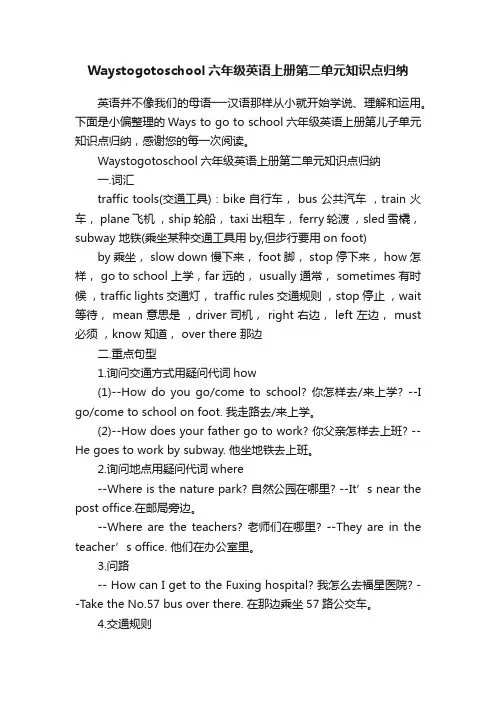
Waystogotoschool六年级英语上册第二单元知识点归纳英语并不像我们的母语──汉语那样从小就开始学说、理解和运用。
下面是小偏整理的Ways to go to school六年级英语上册第儿子单元知识点归纳,感谢您的每一次阅读。
Waystogotoschool六年级英语上册第二单元知识点归纳一.词汇traffic tools(交通工具):bike 自行车, bus 公共汽车,train 火车, plane 飞机,ship 轮船, taxi 出租车, ferry 轮渡,sled 雪橇,subway 地铁(乘坐某种交通工具用by,但步行要用on foot) by 乘坐, slow down 慢下来, foot 脚, stop 停下来, how 怎样, go to school 上学,far 远的, usually 通常, sometimes 有时候,traffic lights 交通灯, traffic rules 交通规则,stop 停止,wait 等待, mean 意思是,driver 司机, right 右边, left 左边, must 必须,know 知道, over there 那边二.重点句型1.询问交通方式用疑问代词how(1)--How do you go/come to school? 你怎样去/来上学? --I go/come to school on foot. 我走路去/来上学。
(2)--How does your father go to work? 你父亲怎样去上班? --He goes to work by subway. 他坐地铁去上班。
2.询问地点用疑问代词where--Where is the nature park? 自然公园在哪里? --It’s near the post office.在邮局旁边。
--Where are the teachers? 老师们在哪里? --They are in the teacher’s office. 他们在办公室里。
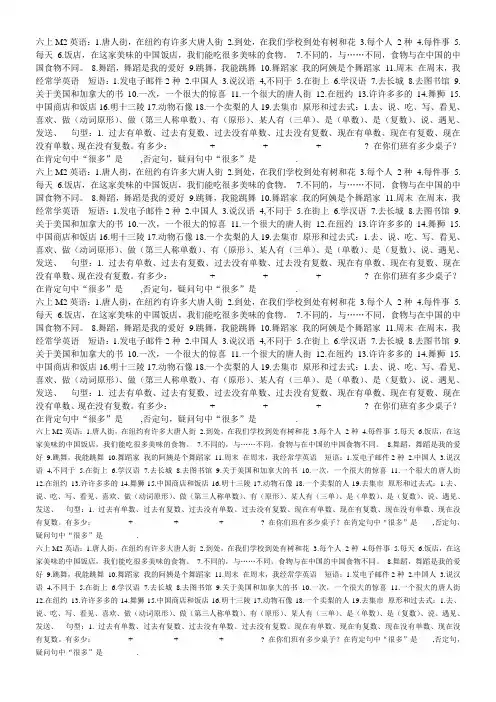
六上M2英语:1.唐人街,在纽约有许多大唐人街 2.到处,在我们学校到处有树和花3.每个人2种4.每件事5.每天 6.饭店,在这家美味的中国饭店,我们能吃很多美味的食物。
7.不同的,与……不同,食物与在中国的中国食物不同。
8.舞蹈,舞蹈是我的爱好9.跳舞,我能跳舞10.舞蹈家我的阿姨是个舞蹈家11.周末在周末,我经常学英语短语:1.发电子邮件2种2.中国人3.说汉语4,不同于5.在街上6.学汉语7.去长城8.去图书馆9.关于美国和加拿大的书10.一次,一个很大的惊喜11.一个很大的唐人街12.在纽约13.许许多多的14.舞狮15.中国商店和饭店16.明十三陵17.动物石像18.一个卖梨的人19.去集市原形和过去式:1.去、说、吃、写、看见、喜欢、做(动词原形)、做(第三人称单数)、有(原形)、某人有(三单)、是(单数)、是(复数)、说、遇见、发送、句型:1. 过去有单数、过去有复数、过去没有单数、过去没有复数、现在有单数、现在有复数、现在没有单数、现在没有复数。
有多少:___ ____+___________+_____ ____+__________? 在你们班有多少桌子?在肯定句中“很多”是____,否定句,疑问句中“很多”是_________.六上M2英语:1.唐人街,在纽约有许多大唐人街 2.到处,在我们学校到处有树和花3.每个人2种 4.每件事5.每天 6.饭店,在这家美味的中国饭店,我们能吃很多美味的食物。
7.不同的,与……不同,食物与在中国的中国食物不同。
8.舞蹈,舞蹈是我的爱好9.跳舞,我能跳舞10.舞蹈家我的阿姨是个舞蹈家11.周末在周末,我经常学英语短语:1.发电子邮件2种2.中国人3.说汉语4,不同于5.在街上6.学汉语7.去长城8.去图书馆9.关于美国和加拿大的书10.一次,一个很大的惊喜11.一个很大的唐人街12.在纽约13.许许多多的14.舞狮15.中国商店和饭店16.明十三陵17.动物石像18.一个卖梨的人19.去集市原形和过去式:1.去、说、吃、写、看见、喜欢、做(动词原形)、做(第三人称单数)、有(原形)、某人有(三单)、是(单数)、是(复数)、说、遇见、发送、句型:1. 过去有单数、过去有复数、过去没有单数、过去没有复数、现在有单数、现在有复数、现在没有单数、现在没有复数。
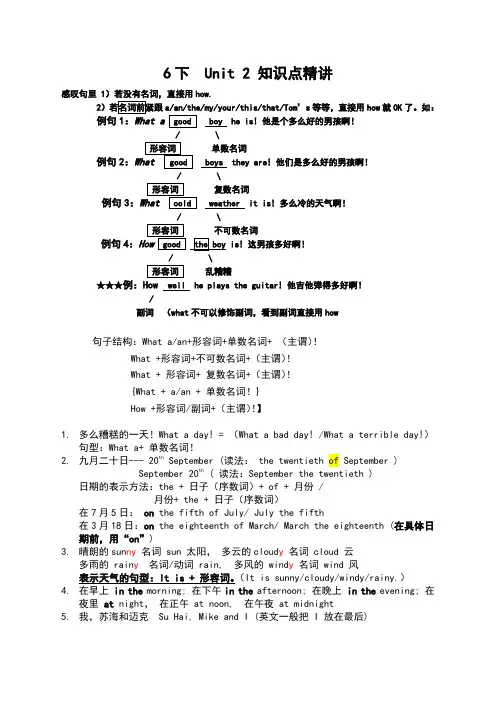
6下 Unit 2 知识点精讲感叹句里 1)若没有名词,直接用how.2a/an/the/my/your/this/that/Tom’s等等,直接用how就OK了。
如:例句1: good boy he is! 他是个多么好的男孩啊!/ \单数名词例句2:good boys they are! 他们是多么好的男孩啊!/ \复数名词例句3: cold weather it is! 多么冷的天气啊!/ \不可数名词例句4:这男孩多好啊!/ \乱糟糟★★★例:How well he plays the guitar! 他吉他弹得多好啊!/副词(what不可以修饰副词,看到副词直接用how句子结构:What a/an+形容词+单数名词+ (主谓)!What +形容词+不可数名词+(主谓)!What + 形容词+ 复数名词+(主谓)!{What + a/an + 单数名词!}How +形容词/副词+(主谓)!】1.多么糟糕的一天!What a day! = (What a bad day! /What a terrible day!)句型:What a+ 单数名词!2.九月二十日--- 20th September (读法: the twentieth of September )September 20th ( 读法:September the twentieth )日期的表示方法:the + 日子(序数词)+ of + 月份 /月份+ the + 日子(序数词)在7月5日: on the fifth of July/ July the fifth在3月18日:on the eighteenth of March/ March the eighteenth (在具体日期前,用“on”)3.晴朗的sun ny名词 sun 太阳,多云的cloud y名词 cloud 云多雨的 rain y名词/动词 rain, 多风的 wind y名词 wind 风表示天气的句型:It is + 形容词。
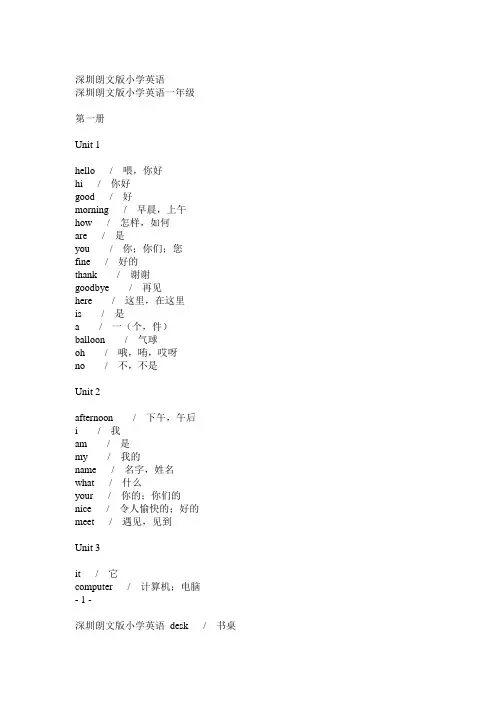
深圳朗文版小学英语深圳朗文版小学英语一年级第一册Unit 1hello / 喂,你好hi / 你好good / 好morning / 早晨,上午how / 怎样,如何are / 是you / 你;你们;您fine / 好的thank / 谢谢goodbye / 再见here / 这里,在这里is / 是a / 一(个,件)balloon / 气球oh / 哦,哊,哎呀no / 不,不是Unit 2afternoon / 下午,午后i / 我am / 是my / 我的name / 名字,姓名what / 什么your / 你的;你们的nice / 令人愉快的;好的meet / 遇见,见到Unit 3it / 它computer / 计算机;电脑- 1 -深圳朗文版小学英语desk / 书桌fan / 风扇;扇子light / 灯,灯光book / 书;本子this / 这,这个classroom / 教室sorry / 对不起,抱歉miss / 小姐,女士(称呼未婚女子)Unit 4bag / 书包pencil / 铅笔pencil case / 铅笔盒pen / 钢笔ruler / 尺子rubber / 橡皮Unit 6point / 指,指向point to / 指向the / 这(那)个,这(那)些board / 黑板door / 门window / 窗户look / 看,观看look at / (仔细)检查,查看sit / 坐sit down / 坐下stand / 站stand up / 起立open / 打开close / 关,关上out / 出局,淘汰children / (复)孩子,儿童Mr(mister)/ 先生(用于姓名前)please / 请- 2 -深圳朗文版小学英语Unit 7mouth / 嘴eye / 眼睛ear / 耳朵finger / 手指draw / 画画one / 一two / 二three / 三four / 四five / 五six / 六seven / 七eight / 八nine / 九ten / 十yes / 是and / 和Unit 8an / 一(个,件)apple / 苹果banana / 香蕉pear / 梨子lychee / 荔枝orange / 橙子mum / (口语)妈妈fruit / 水果salad / 色拉Unit 9red / 红色blue / 蓝色yellow / 黄色- 3 -深圳朗文版小学英语green / 绿色orange / 橙色brown / 褐色的,棕色的me / 我(宾格)very / 很,非常too / 也,还ow / 啊哊,哦第二册Unit 1student / 学生young / 年轻的pioneer / 先锋,开拓者Young Pioneer / 少先队员in / 在……里面class / 班级grade / 年级boy / 男孩girl / 女孩what / 什么(表示惊讶)turn / (轮流的)顺序It’s your turn. / 轮到你了。
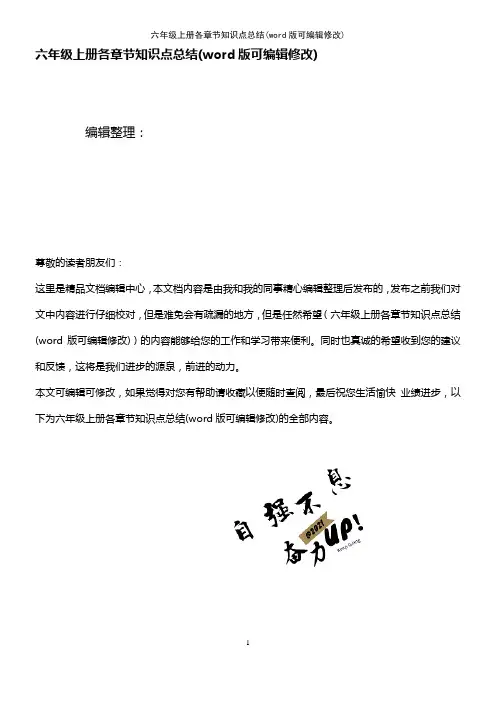
六年级上册各章节知识点总结(word版可编辑修改)编辑整理:尊敬的读者朋友们:这里是精品文档编辑中心,本文档内容是由我和我的同事精心编辑整理后发布的,发布之前我们对文中内容进行仔细校对,但是难免会有疏漏的地方,但是任然希望(六年级上册各章节知识点总结(word版可编辑修改))的内容能够给您的工作和学习带来便利。
同时也真诚的希望收到您的建议和反馈,这将是我们进步的源泉,前进的动力。
本文可编辑可修改,如果觉得对您有帮助请收藏以便随时查阅,最后祝您生活愉快业绩进步,以下为六年级上册各章节知识点总结(word版可编辑修改)的全部内容。
六年级上册各章节知识点总结一、分数乘法一、分数乘法(一)分数乘法的意义:1、分数乘整数与整数乘法的意义相同。
都是求几个相同加数的和的简便运算。
2、分数乘分数是求一个数的几分之几是多少。
(二)分数乘法的计算法则:1、分数与整数相乘:分子与整数相乘的积做分子,分母不变。
(整数和分母约分)2、分数与分数相乘:用分子相乘的积做分子,分母相乘的积做分母。
3、为了计算简便,能约分的要先约分,再计算。
注意:当带分数进行乘法计算时,要先把带分数化成假分数再进行计算。
(三)规律:(乘法中比较大小时)一个数(0除外)乘大于1的数,积大于这个数。
一个数(0除外)乘小于1的数(0除外),积小于这个数。
一个数(0除外)乘1,积等于这个数。
(四)分数混合运算的运算顺序和整数的运算顺序相同.(五)整数乘法的交换律、结合律和分配律,对于分数乘法也同样适用.乘法交换律: a × b = b × a乘法结合律:( a × b )×c = a ×( b × c )乘法分配律:( a + b )×c = a c + b c a c + b c = ( a + b )×c二、分数乘法的解决问题。
根据方向和距离两个条件确定物体的位置。
2。
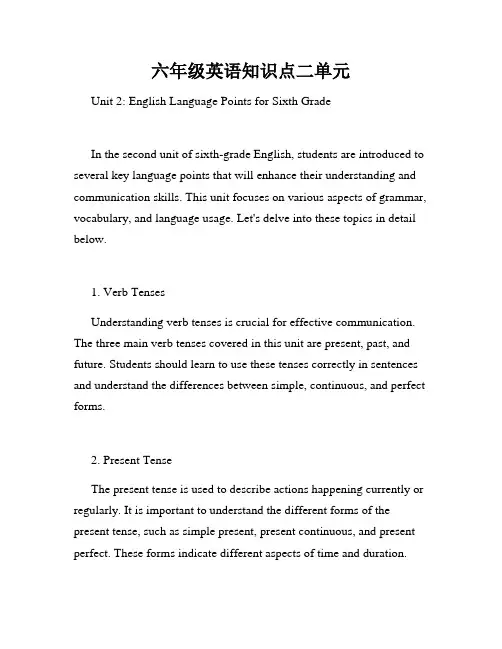
六年级英语知识点二单元Unit 2: English Language Points for Sixth GradeIn the second unit of sixth-grade English, students are introduced to several key language points that will enhance their understanding and communication skills. This unit focuses on various aspects of grammar, vocabulary, and language usage. Let's delve into these topics in detail below.1. Verb TensesUnderstanding verb tenses is crucial for effective communication. The three main verb tenses covered in this unit are present, past, and future. Students should learn to use these tenses correctly in sentences and understand the differences between simple, continuous, and perfect forms.2. Present TenseThe present tense is used to describe actions happening currently or regularly. It is important to understand the different forms of the present tense, such as simple present, present continuous, and present perfect. These forms indicate different aspects of time and duration.3. Past TenseThe past tense is used to talk about actions that have already happened. Students should learn the regular and irregular forms of past tense verbs and understand how to use them correctly in sentences. Additionally, they should be aware of common time indicators like yesterday, last week, or in 2005 that accompany past tense sentences.4. Future TenseThe future tense is used to discuss actions that will happen in the future. Common ways to express the future include using the modal verb "will" or present continuous form with future intentions. Students should practice constructing sentences using future tense structures accurately.5. Parts of SpeechThis section focuses on the different parts of speech, such as nouns, pronouns, verbs, adjectives, and adverbs. Students should understand the roles these words play in sentences and how they can modify or describe other words. Identifying and categorizing words correctly will enhance their overall language skills.6. Vocabulary ExpansionExpanding vocabulary is crucial for effective communication. In this unit, students will learn new words and phrases related to various topics, including daily routines, hobbies, and sports. They should practice using these words in context to improve their speaking and writing skills.7. Sentence StructureUnderstanding sentence structure helps students form grammatically correct and meaningful sentences. They should learn about subject-verb agreement, word order, and sentence types (declarative, interrogative, imperative, and exclamatory) to express their thoughts accurately.8. Reading ComprehensionStudents will engage in reading activities to improve their comprehension skills. They will read texts, answer questions, and develop strategies to extract information from the given passages. This improves their overall understanding of English and enhances their critical thinking abilities.9. Listening and SpeakingListening and speaking exercises are crucial for developing fluency. Students will participate in dialogues, group discussions, and oral presentations to enhance their communication skills. These activities will focus on developing clear pronunciation, appropriate intonation, and accurate usage of language points covered in this unit.In conclusion, the second unit of sixth-grade English covers various language points essential for effective communication. Students should pay attention to verb tenses, parts of speech, vocabulary expansion, sentence structure, and reading comprehension. Engaging in listening and speaking activities will also enhance their overall language proficiency. This unit serves as a solid foundation for further language development.。
朗文6A Chapter Two 学习提要亲爱的同学们,学习了这个章节后,请按照要求检测你的学习结果吧~~Part A and BNew words and phrases(要求:知道中文意思,听懂,会读,会拼写。
)collect stamps:集邮collect coins: 收集硬币paint pictures: 画画make handicrafts: 做手工play the violin: 拉小提琴do ballet: 跳芭蕾do karate: 练空手道grow flowers: 种花(以下词汇要求:知道意思,会读,听得懂)display 展览语法点:现在完成时(要求:理解并会运用。
)一、用法:从过去开始并持续到现在的动作或状态。
二、结构:have/has+过去分词(p.p.)例句:I’ve done karate for five years.I’ve made handicrafts since 2003.三、for和since的用法:for+a period of time: for 后面加时.间段..;since+a starting point: since后面加时间点...;例句:My father has worked at the company for 12 years.My mother has lived in this city since 2000.四、How longMy father has worked at the company for 12 years. (划线部分提问) How long has your father worked at the company?My mother has lived in the city since 2000. (划线部分提问)How long has your mother lived in the city?五、过去分词的变化(Chapter 2)规则变化:paint-painted; play-played; collect-collected;不规则变化:do-done; make-made; grow-grown; be-beenwrite-wri tt en; hear-heardPart C and DRecite Part C(头脑敏捷的你,快快挑战这个记忆力大考验吧~~熟练背诵C部分吖。
龙文学校个性化辅导教案教师:学生:年级:时间:第次一、授课目的与考点分析1、目标:新授六上U22、重难点:四会词句,音标复习,巩固运用二、主题与教学过程:Step 1 Warm-up元音(20个)长元音/ɑ://ɔ:/ / ɜ:/ /i:/ /U:/短元音/ ʌ/ /ɒ/ /ə/ /ɪ/ /ʊ/ /e/ /æ/双元音/eɪ/ /aɪ/ /əʊ/ /aʊ//ɪə/ /eə/ /ʊə/ /ɔɪ/辅音(28个)轻辅音/p/ / t/ / k/ /f/ /s/ /θ/浊辅音/b/ /d/ /g/ /v/ /z/ /ð/轻辅音/ʃ/ /tʃ/ /ts/ /tr/ /h/浊辅音/ʒ/ /dʒ/ /dz/ /dr/ / r/鼻音/m/ /n/ /ŋ/半元音/ j/ / w/边音/ ǀ/词末尾:/ ǀ/R e a d a n d w r i t e:['laibrəri]_________ [pəust] ['ɔ:fis]__________ ['hɔspitl]__________ ['sinimə]__________ ['bukstɔ:]__________ ['saiəns] [mju:'zju:m]___________________ [iks'kju:z]________ ['nekst] [tu:]__________ [fɑ:]__________ ['ɑ:ftə] [sku:l]__________ [w∧nt]__________ [tə:n]__________[rait]__________[left]__________ [streit]__________ [ðen]__________[tel]__________ [teik]__________ [luk] [fɔ:]__________Step 2 Unit 2 Ways to go to schoolPresentation: The voice of the vehicleNew contentsWords and expressionsStructures:①询问交通方式用疑问代词how⏹——How do you go to school ? 你怎样去上学?/come to school(来学校)—— I go to school on foot . 我走路去上学。
六年级上Unit 2学习资料班级_______ 姓名_______ 一.四会词和词组(听,说,读,写):north北方capital首都famous著名culture文化busy热闹的,忙碌的by靠近map地图left左侧right右侧river江,河take the first left在第一个路口左转take the second right在第二个路口右转take the third left在第三个路口左转二. 三会词(听,说,读):London伦敦Washington DC华盛顿特区the UK/England英国the US美国country国家interesting有趣的place地方most最popular受欢迎的visit参观postcard明信片queen王后Manchester曼彻斯特road路around环绕direction方向building建筑across穿过join连接enter进入三.会词组(听,说,读):the Great Wall长城the Palace Museum故宫博物院Tower Bridge塔桥the London Eye伦敦眼the White House白宫the Smithsonian Castle史密森尼城堡Big Ben大本钟the British Museum大英博物馆lots of许多at the moment此刻In the middle of在......中间Hyde park海德公园full of充满National Gallery国家美术馆New York纽约twin towers双子塔one of…之一fell(fall过去式) down World Trade Center世界贸易中心from west to east自西向东East Lake东湖四.四会句(听,说,读,写):1.Beijing is the capital of China.北京是中国的首都。
六年级上册英语知识点归纳Unit2: Ways to go to school一、重点单词和短语1. 四会词汇:on foot步行=walk by bus =take a/the bus 乘公交车by plane,乘飞机by taxi 乘出租车by ship乘船by subway 乘地铁by train乘火车by bike骑自行车slow down 慢下来stop 停止wait等go走了解:by…= take a / the …例如:by bus = take a / the bus2. 频率副词:(次数从多到少)always总是> usually通常> often 经常> sometimes有时> never从不3. 其他:pay attention to注意by ferry乘轮渡by sled滑雪橇cross the road横穿马路traffic light(s) 通信号灯at home在家missed(miss的过去式)想念different不同的same 相同的cross穿过look right向右看chopsticks筷子(复数)door门look at朝……看play with和……一起玩Hooray好极了二、按要求写单词:go (反义词)come foot(复数)feet child(复数)childrengood(反义词)bad坏的take带走(反义词)bring拿来slow慢的(反义词)quick/fast go(过去式)went do(过去式)did do(第三人称单数)doesgo(第三人称单数)goes same 相同的(反义词)different不同的miss(过去式)missed wrong 错误(反义词)right正确can(否定形式)can’t early早的(反义词)late晚的三、重点句子(一)四会句子1. --- How do you come to school? 你(们)怎么来学校的?--- Usually, I come on foot. = Usually, I walk. 通常情况下,我步行来。
Unit 2 重难点知识归纳
一、译一译
新西兰珠穆朗玛峰布达拉宫
泼水节the name of this place 在世界上
在中国the longest river 最大的城市
Get some rest 最高的山study hard
The youngest surfer 锦绣中华照照片
全世界穿上模型公园
长城Dragon Boat races
二、填空
1.Which country has this ?哪个国家有这面国旗?、
2. What’s the name of this ?这个地方叫什么名字?
3. It’s time bed now. 现在是该睡觉的时间了。
4. Today is day of the year. 今天是一年中最热的一天。
5.The longest river in China is .在中国最长的河流是长江。
6. is the (two) longest river in China.黄河是中国第二长的河流。
7.Chongqing is city in China.重庆是中国最大的城市。
8.Lhasa city in China.拉萨是中国海拔最高的城市。
9.Potala Palace is palace in the world.布达拉宫是世界上最高的宫殿。
10.Mount Qomolangma mountain in the world.珠穆朗玛峰是世界上最高的山峰。
11. is the biggest in the world.锦绣中华是世界上最大的模型公园。
12.The Dead Sea (salty)sea on the earth .死海是世界上最咸的海。
三、形容词比较级和最高级的变化规则:
tall light weak fast
nice brave polite heavy
easy happy noisy fat
thin big hot wet
red high large salty。